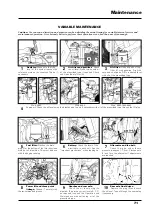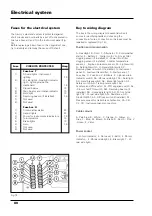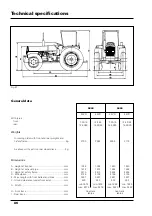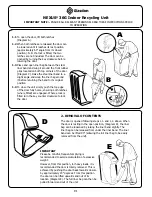
Electrical system
79
Contact a specialized workshop if distilled water
must be added to the battery more frequently.
Never allow the battery to run down completely.
Recharge it once a month if necessary
.
Warning:
Battery electrolyte contains
sulphuric acid and can cause serious burns.
AVOID contact with the skin and eyes. Keep
naked flames, sparks and lit cigarettes WELL
CLEAR of batteries which are being charged.
Keep the area in which batteries are being
charged well ventilated.
Starter motor
Every 1000 hours, or once a year, clean the starter
motor thoroughly and, in particular, check if the brushes
and collector are worn.
Alternator
The alternator keeps the battery fully charged.
The alternator is a brushless model and requires no
special maintenance. However, the following precau-
tions must be observed.
1. When fitting a battery, make sure that the positive
and negative terminals are connected to the same
leads as the alternator. If you make the wrong
connection, you will short circuit the battery through
the alternator diodes. This not only discharges the
battery but also burns out the diodes and leads.
2. When connecting the battery to a charger, make sure
that the positive (+) lead of the charger is connected
to the positive of the battery, and the negative (-) to
the negative. Incorrect connection will damage the
alternator diodes and other circuit components.
3. Never run the alternator unless it is properly con-
nected. If the battery is not connected, high
voltages can build up inside the alternator that can
be extremely dangerous if the output terminal is
touched. Make sure that all connections are firm
and tight before carrying out any inspections or
tests on the electrical system.
4. Never short circuit or earth any of the alternator
terminals. This could damage the electrical system.
5. Never invert the alternator connections. The battery
and alternator earths must be of the same sign or
the alternator diodes will be damaged.
6. Always disconnect both the alternator terminals
before undertaking any electric arc welding on the
tractor.
Headlights
As you can use your tractor on public roads, the lighting
must comply with applicable traffic and road regula-
tions. Periodically check headlight alignment in the
following way (Fig. 74):
Halt the tractor on level ground facing a shaded wall
(preferably white). The tractor must be unloaded
and the tyres correctly inflated. Mark two crosses
on the wall in front of the tractor headlights.
Reverse the tractor 5 meters (16.4 ft) away from the
wall.
Switch on the dipped beam. The center of each
beam must be vertically aligned with the crosses on
the wall. A maximum outward divergence of 130
mm (5 in.) is acceptable.
Switch on the main beam. The line separating the lit
area from the dark area must fall below the crosses
and must be separated from their centers by at
least 1/20th of the height of the crosses from the
ground.
Adjust the headlight alignment screws to correct
alignment as necessary.
Fig. 74- Checking headlight alignment
















































